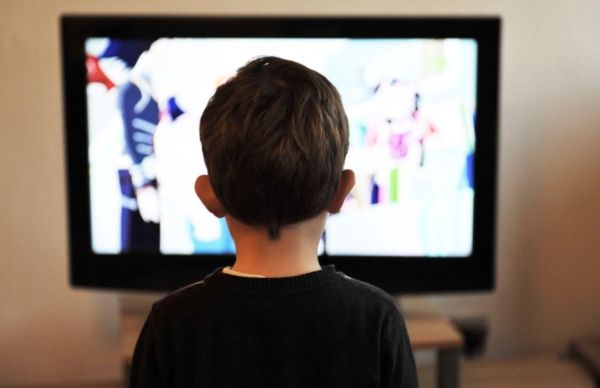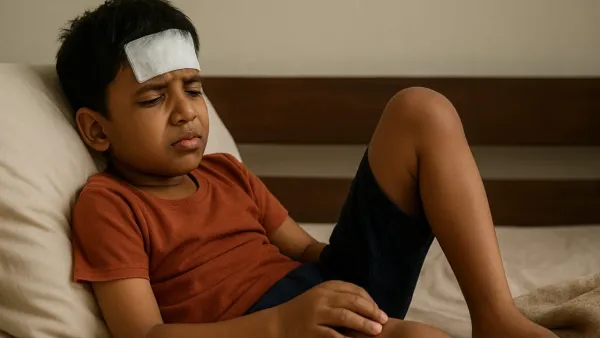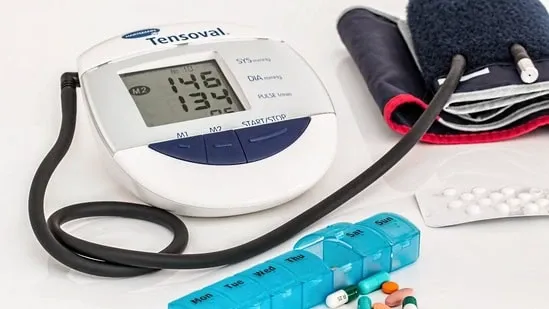
Squinting
Some signs are easy to notice than others. If a child is squainting often, sitting too close to the television, or holding books and devices very close, it may point to vision problems. Squinting helps them sharpen blurry images, while moving closer makes objects look bigger and clearer.
Tilting
Tilting the head or covering one eye is another common sign. This can happy when the eyes are not working well togetra, and the child is trying to improve focus with one stranger eye.
Headaches or Eye Pain
Complaints of Headaches or Eye Pain, Especially at the End of the Day, May also sugges that their eyes are working
Other red flags
Excessive Eye Rubbing, Clumsiness, or Poor Hand-Eye Coordination are other red flags that should not be ignored.
Vision signs in babies aged 0–6 months
Spotting Vision Problems in Babies Can Be Tricky Since they cannot explain what they see. But there are certain behaviors parents can watch for. By Around Six Weeks, Babies Usually Follow Colorful Objects or Patterns with their eyes. They should also turn towards sounds and begin recognizing faces.
At this stage, a newborn can only focus on things close to them. So, it’s normal if they do’t notice objects far across the room. Sometimes, their eyes may also also drift in slightly different directions, which is common. But if the squint seems constant or they do’t respond to expressions and gestures, it may signal a problem that needs attentions.
Signs in Babies 6 Months and Older
By Six Months, A Baby’s Eyes are more developed. They should start Judging Depth, Focusing on Objects Across the Room, and Following Movement with Ease. If your baby struggles to track objects or doesn Bollywood interested in focusing on things you point out, it would be a sign of POOR VITIOI.
Parents can try a simple check by gently covering one eye at a time. If the baby reacts strongly or seems upset when one particular eye is covered, it may sugges weaker vision in the other eye.
General Signs in Toddlers and Older Children
As Children Grow, The Signs of Vision Trouble Backser to Notice. A Child May Hold Objects Too Close to their face, screenw up their eyes to see better, or complain about blood or double vision. They may also also avoid drawing, reading, or prefer activities that do not strain their sight.
Some children may appear clumsy, bump into things, or show poor coordination during play. Sitting too close to the tv, avoiding up-close activities, or having frequent headaches are all signs that parents should take take care Vision Problems can also look like behavior issues in school, as kids who can’t see clear often lose focus and struggle to keep up.
Four tips for parents
Parents play a key role in protecting their child’s eye health. The first tip is simple: pay close Attention to changes in your child’s behavior. Kids duan’t usually know they have poor vision, so small cloes like squainting or getting to geting too close to screens can reveal a lot.
Second, Remember that Vision Problems Can Affect School Performance. A child who seems inattentient in class may actually be struggling to see the board or their books clear. Regular Eye Checks Can Prevent this from Being Mistaken for Lack of Interest.
Third, Limit screen Time and Encourage better screen habits. Tablets and phones help close to the eyes put more strain on vision. Watching content on a larger screen at a distance is healthier, and computer work should be done on a monitor kept at Arm’s length.
Finally, Make outdoor play a daily routine. Natural Sunlight and Focusing on distant objects helx relax the eyes and reduce the risk of nearsightedness. An hour outside every day can go a long way in supporting healthy vision.
-
Doctors report rare viral infection causing leg pain, numbness in Indians

-
AIIMS gastroenterologist shares top 10 gut friendly snacks you can have daily: Makhana, sprouted moong chaat, buttermilk

-
Cardiologist recommends this ‘number 1 habit to every patient with high blood pressure’: Here’s what to do daily

-
SpiceJet Stock Soars On Settlement With Carlyle Aviation Partners

-
Bitcoin, Ether ETF Flows Surge Ahead Of CPI Data, Solana Steadies After Hitting 7-Month High
